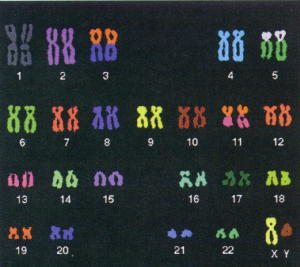This post is quite wordy – but bare with it and work through it in chunks!
Your DNA is divided into sections called genes.
On each gene, the base sequence codes for a particular protein. These proteins determine your characteristics.
Your DNA is arranged to form chromosomes, you have 23 pairs of chromosomes in each cell in your body (making 46 in total). You receive one set from your mother and other from your father.
 As you can see in the image above, the chromosomes are arranged into pairs. These are called homologous pairs of chromosomes. Homologous chromosomes are pairs of chromosomes which have the same genes on them in the same place on the chromosome. This place is called the locus of the gene.
As you can see in the image above, the chromosomes are arranged into pairs. These are called homologous pairs of chromosomes. Homologous chromosomes are pairs of chromosomes which have the same genes on them in the same place on the chromosome. This place is called the locus of the gene.
Although they have the same genes, they may have a different version of that gene (remember pokemon versions). These different versions of the same gene are called alleles. Different alleles have slightly difference base sequences, so produce a protein with a slightly different amino acid sequence and so the protein is a different shape. Eg. One of the chromosomes in a pair may have the blue eye allele, but the other might have the brown eye allele.
If the base sequence of an allele (or gene) is missing or copied incorrectly, then this will disrupt the structure of whatever protein it codes for. Eg. People with cystic fibrosis have a faulty CFTR protein. This is because the protein is the wrong shape because the cystic fibrosis allele has 3 bases (nucleotides) missing – meaning it is missing one amino acid.
Remember that enzymes are proteins – this means that every enzyme in your body must have been produced to the instructions in your DNA. Enzymes control lots of metabolic pathways in your body – and these metabolic pathways give rise to many of your characteristics. A metabolic pathway is:
- a series of chemical reactions
- catalysed by enzymes
- the product of one reaction is usually the substrate in the next reaction in the chain (so the next reaction in the chain cannot happen until the one before it has happened)
In exams they like to give you examples of metabolic pathways and ask you to explain why certain things may happen. They will always give you the information you need, but they are often looking for what is happening to the base sequence of the alleles, or amino acid sequence in a protein. Look at Question 3 from Jan 2012 for an example question.

29/07/2015 at 09:12
This web site truly has all of the information I wanted about
this subject and didn’t know who to ask.